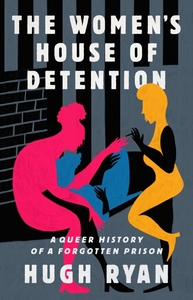You need to sign in or sign up before continuing.
Take a photo of a barcode or cover
informative
reflective
medium-paced
I really enjoyed reading this, though enjoy isn’t quite the right word given the subject. It quite nicely ties together the compounding conditions of class, race, gender, and queerness to weave a thorough history of the prison, despite only being able to highlight so many people’s experience. I think this is a good introduction for queer folks looking to get more into prison abolition, it touches on many factors that make prisons irredeemable. The structure kept me engaged throughout, but called back to certain details so often it got annoying/redundant a bit (love you big cliff but i don’t need to hear your name every time a butch being mistreated occurs).
Graphic: Medical trauma
Moderate: Addiction, Confinement, Homophobia, Misogyny, Racism, Sexual assault, Transphobia, Forced institutionalization, Police brutality, Suicide attempt, Lesbophobia, Classism
It covers a lot of things worth content warnings but nothing was described too gratuitously.
challenging
informative
inspiring
reflective
medium-paced
informative
sad
challenging
informative
inspiring
reflective
slow-paced
I typically enjoy recounts of queer history. I am having a hard time on why I didn’t love this one… I think it had to do with the short summaries of people’s time, the short recounts of Mary or Sue or Sam. It was hard to connect to such passing summaries, they didn’t really feel real.
There also wasn’t a narrator to follow on the discovery of everything, no homey touches of interviewing someone. There was no one for me to anchor to as we recounted the prison’s history.
I think it was that this really is a straight up history book. I learned a lot, it was sad a lot, but perhaps stylistically, this wasn’t for me. Content was well organized tho and the bibliography is impressive.
Special thanks to the publisher and NetGalley for an eARC in exchange for an honest review.
There also wasn’t a narrator to follow on the discovery of everything, no homey touches of interviewing someone. There was no one for me to anchor to as we recounted the prison’s history.
I think it was that this really is a straight up history book. I learned a lot, it was sad a lot, but perhaps stylistically, this wasn’t for me. Content was well organized tho and the bibliography is impressive.
Special thanks to the publisher and NetGalley for an eARC in exchange for an honest review.
From 1929 to 1974, there was a prison in Greenwich Village called The Women's House of Detention. Ryan opens up the records and inflates the history of the people housed there into stories about human beings.
"To look at prisons historically is to see a monstrously efficient system doing exactly what it was designed to do, hide every social problem we refuse to deal with."
Once again I learned astronomical truths about the history of my country and how we got into the mess we're in today. Ryan doesn't just recreate human stories, he builds the ethos of the times and wow did we do a doozy on our citizens after World War II. The propaganda machine of the American 1950s linked communism with queerness and the "lavender scare" became a whole new way to punish people for stepping outside the established norms.
Women were arrested for prostitution, not men, because it was the offer of sex that was illegal. Not the act. Women with STDs were arrested and imprisoned to prevent the spread to men.
Ryan effectively demonstrates how easy it was for a woman to slip through the cracks of society, and once she did it was nearly impossible to crawl out from the underbelly.
"Three interrelated forces would dominate and ultimately ruin Anne's life. The stigma of her incarceration, the lack of treatment for her mental health, and her inability to find and keep a good job."
The conditions in the prison were atrocious. The physical exam the women were subjected to was abuse. It was illegal to prescribe drugs to an addict so the addicted we're forced to go cold turkey, yet everyone was drugged with excessive amounts of thorazine.
Yes this was a hard book. It's a hard history to learn. An even harder one to have survived. Now a private park and a plaque memorialize this prison, the relic of a system far more interested in punishment than reform.
"To look at prisons historically is to see a monstrously efficient system doing exactly what it was designed to do, hide every social problem we refuse to deal with."
Once again I learned astronomical truths about the history of my country and how we got into the mess we're in today. Ryan doesn't just recreate human stories, he builds the ethos of the times and wow did we do a doozy on our citizens after World War II. The propaganda machine of the American 1950s linked communism with queerness and the "lavender scare" became a whole new way to punish people for stepping outside the established norms.
Women were arrested for prostitution, not men, because it was the offer of sex that was illegal. Not the act. Women with STDs were arrested and imprisoned to prevent the spread to men.
Ryan effectively demonstrates how easy it was for a woman to slip through the cracks of society, and once she did it was nearly impossible to crawl out from the underbelly.
"Three interrelated forces would dominate and ultimately ruin Anne's life. The stigma of her incarceration, the lack of treatment for her mental health, and her inability to find and keep a good job."
The conditions in the prison were atrocious. The physical exam the women were subjected to was abuse. It was illegal to prescribe drugs to an addict so the addicted we're forced to go cold turkey, yet everyone was drugged with excessive amounts of thorazine.
Yes this was a hard book. It's a hard history to learn. An even harder one to have survived. Now a private park and a plaque memorialize this prison, the relic of a system far more interested in punishment than reform.
hopeful
informative
reflective
medium-paced
I found this in NYC & was intrigued. I’ve always been interested in ethical ambiguities around crime & punishment, & the intersection here with queerness & feminism struck me.
This book is a scathing review of the modern industrial incarceration phenomenon, using the history of one building to crack into the way that power structures have traditionally institutionalised certain populations. Looking at behaviours which were seen as bohemian for some, and morally corrupt for others, as well as actions borne of desperation, Ryan makes a real statement about what’s wrong with our approach to crime.
I was struck by a lot of these stories! It’s a privilege to read stories Ryan dredged up from documentation, stories which could’ve otherwise been lost & buried.
I will keep thinking about:






